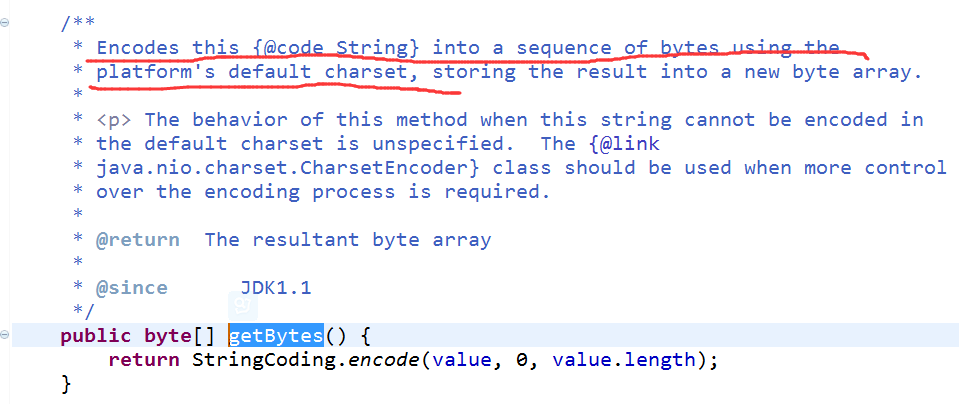转载请注明出处:http://www.cnblogs.com/Joanna-Yan/p/6900536.html
Java服务器后台在和Android端App通信时,遇到了两端关于用MD5加密同一包含中文的字符串结果不一致的问题。
具体问题描述:
Java服务器后台和Android端AS用了同一个MD5的工具类,且两边项目的默认编码都是UTF-8 ,加密纯英文数字的字符串时,结果一致,对同一包含中文的字符串加密,发现结果不一样,这是为什么呢?
工具类MD5Util代码如下:
public class MD5Util { /** * 将byte数组转化为16进制输出 * @param bytes * @return */ public static String convertByteToHexString(byte[] bytes){ String result=""; for (int i = 0; i < bytes.length; i++) { int temp=bytes[i]&0xff; String tempHex=Integer.toHexString(temp); if(tempHex.length()<2){ result+="0"+tempHex; }else{ result+=tempHex; } } return result; } /** * MD5加密 * @param message * @return * @throws UnsupportedEncodingException */ public static String md5Jdk(String message) throws UnsupportedEncodingException{ String temp=""; try { MessageDigest md5Digest=MessageDigest.getInstance("MD5"); byte[] encodeMD5Digest=md5Digest.digest(message.getBytes()); temp=convertByteToHexString(encodeMD5Digest); } catch (NoSuchAlgorithmException e) { e.printStackTrace(); } return temp; } }
最后问题锁定在:


IDE的项目默认编码和平台运行环境的编码不是一回事。
改成:message.getBytes("UTF-8");后能解决中文加密不一致的问题。

下面,就String的getBytes()方法深入了解下。
String的getBytes()方法是得到一个字符串的字节数组,但特别要注意的是,本方法将返回该操作系统默认的编码格式的字节数组。如果你在使用这个方法时不考虑这一点,你会发现在一个平台上运行良好的系统,放到另一台机器上会产生意想不到的问题。
比如下面的程序:
public class TestCharset { public static void main(String[] args) { new TestCharset().execute(); } private void execute() { String s = "Hello!你好!"; byte[] bytes = s.getBytes(); System.out.println("bytes lenght is:" + bytes.length); } }
在一个中文WindowsXP系统下,运行时,结果为:
bytes lenght is:12
但是如果放到了一个英文的UNIX环境下运行:
$ java TestCharset bytes lenght is:9
如果你的程序依赖于该结果,将在后续操作中引起问题。为什么在一个系统中结果为12,而在另外一个却变成了9?上面已经提到了,该方法是和平台(编码)相关的。
在中文操作系统中,getBytes方法返回的是一个GBK或GB2313的中文编码的字节数组,其中中文字符各占两个字节。而在英文平台中,一般的默认编码是“ISO-8859-1”,每个字符都只取一个字节(而不管是否非拉丁字符)。
Java中的编码支持
Java是支持多国编码的,在Java中,字符都是以Unicode进行存储的,比如,“你”字的Unicode编码是“4f60”,我们可以通过下面的实验代码来验证:
public class TestCharset { public static void main(String[] args) { char c = '你'; int i = c; System.out.println(c); System.out.println(i); } }
不管你在任何平台上执行,都会有相同的输出:
20320
20320就是Unicode “4f60”的整数值。其实,你可以反编译上面的类,可以发现在生产的.calss文件中字符“你”(或者其它任何中文字串)本身就是以Unicode编码进行存储的:
char c = '/u4F60'; ... ...
即使你知道了编码的编码格式,比如:
javac -encoding GBK TestCharset.java
编译后生成的.class文件中仍然是以Unicode格式存储中文字符或字符串的。
所以。为了避免这种问题,建议大家都在编码中使用String.getBytes(String charset)方法。
下面我们将从字串分别提取ISO-8859-1和GBK两种编码格式的字节数组,看看会有什么结果:
public class TestCharset { public static void main(String[] args) { new TestCharset().execute(); } private void execute() { String s = "Hello!你好!"; byte[] bytesISO8859 = null; byte[] bytesGBK = null; try { bytesISO8859 = s.getBytes("iso-8859-1"); bytesGBK = s.getBytes("GBK"); } catch (java.io.UnsupportedEncodingException e) { e.printStackTrace(); } System.out.println("-------------- /n 8859 bytes:"); System.out.println("bytes is: " + arrayToString(bytesISO8859)); System.out.println("hex format is:" + encodeHex(bytesISO8859)); System.out.println(); System.out.println("-------------- /n GBK bytes:"); System.out.println("bytes is: " + arrayToString(bytesGBK)); System.out.println("hex format is:" + encodeHex(bytesGBK)); } public static final String encodeHex(byte[] bytes) { StringBuffer buff = new StringBuffer(bytes.length * 2); String b; for (int i = 0; i < bytes.length; i++) { b = Integer.toHexString(bytes[i]); // byte是两个字节的, 而上面的Integer.toHexString会把字节扩展为4个字节 buff.append(b.length() > 2 ? b.substring(6, 8) : b); buff.append(" "); } return buff.toString(); } public static final String arrayToString(byte[] bytes) { StringBuffer buff = new StringBuffer(); for (int i = 0; i < bytes.length; i++) { buff.append(bytes[i] + " "); } return buff.toString(); } }
执行结果:
-------------- /n 8859 bytes: bytes is: 72 101 108 108 111 33 63 63 63 hex format is:48 65 6c 6c 6f 21 3f 3f 3f -------------- /n GBK bytes: bytes is: 72 101 108 108 111 33 -60 -29 -70 -61 -93 -95 hex format is:48 65 6c 6c 6f 21 c4 e3 ba c3 a3 a1
可见,在s中提取的8859-1格式的字节数组长度为9,中文字符都变成了“63”,ASCII码为63的是“?”,一些国外的程序在国内中文环境下运行时,经常会出现乱码,上面布满了“?”,就是因为编码没有进行正确处理的结果。
而提取的GBK编码的字节数组中正确得到了中文字符的GBK编码。字符“你”、“好”、“!”的GBK编码分别是:“c4e3”、“bac3”、“a3a1”。得到了正确的以GBK编码的字节数组,以后需要还原为中文字串时,可以使用下面方法:
new String(byte[] bytes, String charset)
如果此文对您有帮助,微信打赏我一下吧~


作者:Joanna.Yan
出处:http://www.cnblogs.com/Joanna-Yan/
本文版权归作者所有,欢迎转载,但未经作者同意必须保留此段声明,且在文章页面明显位置给出原文链接,否则保留追究法律责任的权利。





